George Woodroffe Goyder , son of David George Goyder, physician and Swedenborgian minister, and his wife Sarah, nee Etherington. The family later moved to Glasgow where George studied surveying and was articled to a railway engineer. He migrated to
Sydney in 1848. After three years with an auctioneering firm he visited
Melbourne and went to
Adelaide where he decided to settle. In June 1851 he entered the South Australian civil service as a draftsman and on 10 December at Christ Church, North
Adelaide, married Frances Mary Smith.
Goyder joined the Department of Lands as chief clerk in January 1853. In quick stages he rose from second assistant to assistant surveyor-general in January 1857. In April he took charge of an exploration to report on country north of pastoral settlement. He was amazed to find
Lake Torrens full of fresh water and its flourishing eastern surroundings very different from
the desert described by Edward Eyre in 1839. His exuberant report persuaded the surveyor-general, Captain (Sir) Arthur Freeling, to examine the area in September. No more rain had fallen but hot winds had killed the vegetation and turned the lake into a bed of mud. Freeling returned to criticize Goyder for mistaking flood for permanent water, being misled by mirage and misconceiving the value of the northern country. Although Goyder had proved that Eyre's horseshoe of salt lakes was penetrable and thereby opened the way to further exploration, he was too conscientious to ignore his blunder and in 1859 at his own request led survey parties to triangulate the country between Lakes Torrens and Eyre and to sink wells. When Freeling resigned Goyder was recalled from the north to become surveyor-general on 19 January 1861 at a salary of £700.
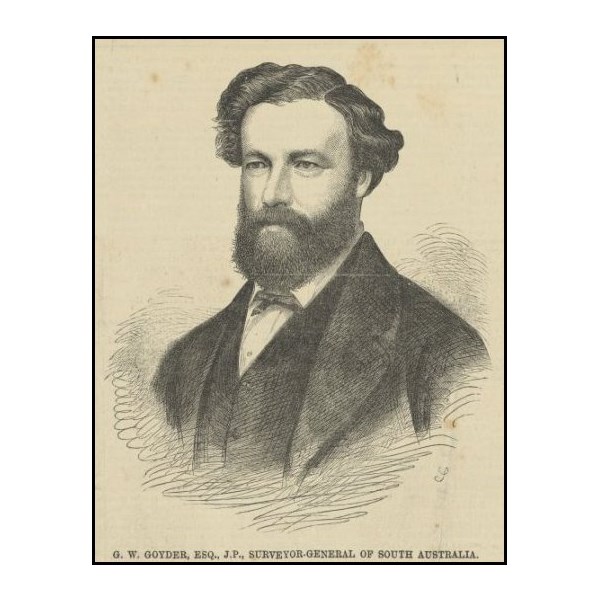
G.W. Goyder, Esq., J.P., Surveyor-General of South Australia
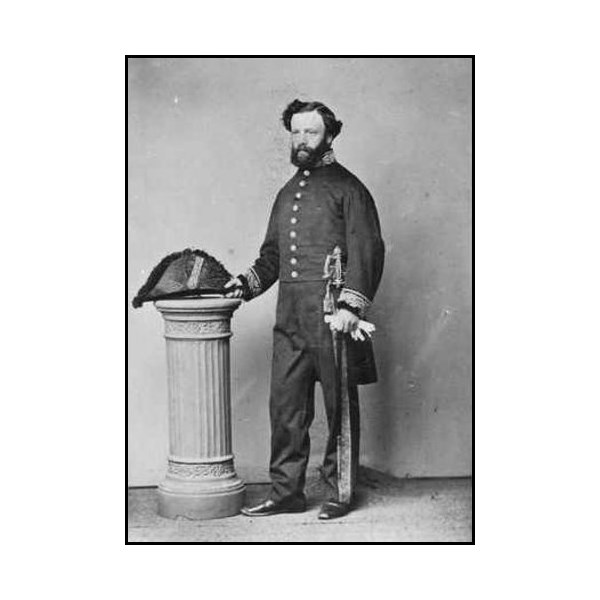
George Woodroffe Goyder 1863
Goyder's northern surveys had attracted many large pastoralists who soon demanded modified conditions for their leases. With extra duties as inspector of mines and valuator of runs Goyder went north to classify grazing leases, rents and rights of renewal. In less than twenty months he rode over 20,000
miles (32,186 km), visiting 83 stations and handling his departmental correspondence each night. When his valuations were published the outback lessees complained bitterly and inside pastoralists demanded re-assessment while smallholders and urban anti-squatters condemned any concession to hungry graziers. In this three-sided struggle four ministries rose and fell but Goyder stood firm. In 1865 three commissioners were sent north to reassess rents but found the country in severe drought. In November Goyder was directed to go north and from his own observations to lay down on the map 'the line of demarcation between that portion of the country where the rainfall has extended, and that where the drought prevails'. With a small mounted party he went to Swan Reach on the River Murray and thence north-west to Pekina, east to
Melrose and returned through
Crystal Brook to
Adelaide. A map published in 1866 showed his line of travel with a wing sweeping east from the Murray to the Victorian border and another from Spencer Gulf far to the west.
Goyder's rainfall line was first used for the reassessment of leases and the relief of stricken pastoralists. After the drought broke in 1867 he cautiously admitted that his line separated 'to a certain extent' lands suitable for agriculture and those fit only for grazing. This statement strengthened the urban land reformers in the general election in April 1868. Led by Henry Strangways they introduced 'Agricultural Areas' where sections up to 320 acres were to be sold at auction on credit, thus enabling small farmers to compete against wealthy speculators. When the new Act was passed in January 1869 Goyder had chosen six areas, each with easy access to the coast.
Goyder's line starts on the west coast near
Ceduna and goes south-east across Eyre Peninsula to strike Spencer Gulf near
Arno Bay. It continues from near
Moonta north to
Crystal Brook and
Orroroo then south-east past
Peterborough and
Burra to the Victorian border near
Pinnaroo, crossing the
Murray River south of
Blanchetown. Much of the land immediately north of the line is covered by saltbush. Agriculture is possible near the
Murray River further upstream only because of irrigation using water drawn from the Murray.
It is easy to see Goyder's line when flying over this area. The change in flora is very distinct when one knows what to look for
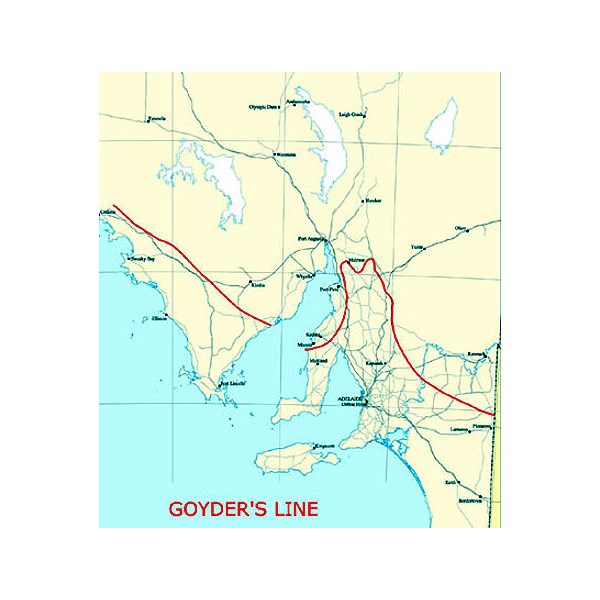
Map Showing Goyder's Line
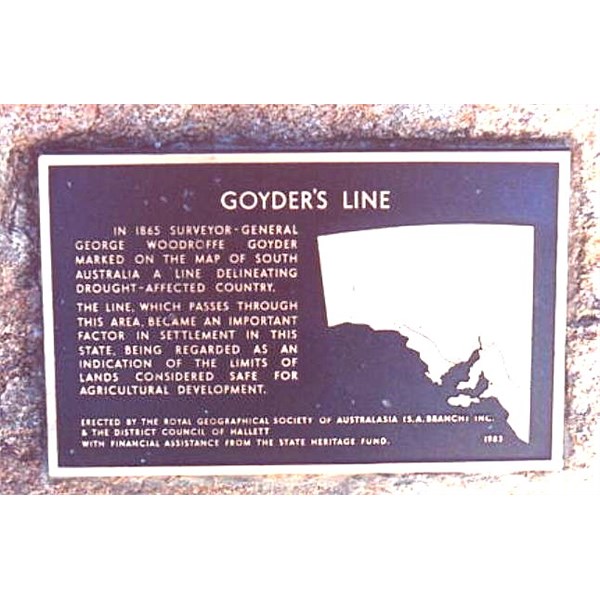
Goyder's Line, This plaque was erected at Terowie
The South Australian government sent George Goyder to the Top End in 1869 to survey the town of Palmerston (now
Darwin) and the rural hinterland almost to the
Adelaide River. He took 150 men to the Northern Territory where incompetence and delay in the surveys were causing much discontent. His prompt and firm action soon restored confidence.
By September 1869 the party had surveyed
Darwin and 665,866 acres of land extending east to the
Adelaide River flood plains, west toward the
Daly River, and south towards the later site of
Adelaide River township. Virtually the whole of what is now the
Litchfield Shire was surveyed in this way, except for the eastern edge, toward the
Adelaide River.
Goyder's men also laid out a two chain road from Port
Darwin to Daly. This "Fred's Pass Road" was intended to be the main road leading inland.
The work performed by Goyder and his men was certainly one of the most remarkable achievements in the whole of the Territory's history. It was the foundation for later
European settlement.
He recommended Palmerston (
Darwin) as the capital site, completed the survey of 665,860 acres in six months, reported on traces of minerals and located a million acres of average quality suitable for the growth of tropical products. He sailed for
Adelaide in November and next February visited Victoria to see the working of land regulations there. He disliked random selection before survey but his mission led to amendments of Strangways' Act. Liberal extensions of credit to new farmers and good seasons in the 1870s brought land sales of nine million acres for the decade. With larger sections and better opportunities to buy land in
well-watered areas he discouraged attempts at farming beyond his line. He pursued this policy as chairman of the railways commission in 1874-75 but northern newspapers claimed that the southern districts were full and ridiculed the accuracy of the line. Scorning Goyder's warnings the government yielded in 1874 and made land available beyond the line. Farmers pushed north and had fair harvests but the onset of bad seasons in 1880 left them in dire distress. At great expense they had to be relocated south of the line, their sections reverting to sheep runs spoiled by wind erosion and destruction of native vegetation.
One of Goyder's many enterprises sprang from the colony's severe shortage of timber. He did his utmost to preserve trees and encourage planting. In 1873 he recommended the use of forest
reserves and in 1875-83 was chairman of the Forest Board with
John Ednie Brown as chief conservator. Another constant project of Goyder's was water conservation. Starting with wells and dams on northern stockroutes he persuaded the government to spend £300,000 on drainage in the south-east in 1867. In 1871 he inspected pumping machinery and irrigation works in Britain and America and returned to
Adelaide with much knowledge of boring for artesian water. He advised many pastoralists on water problems and rejected such impracticable schemes as irrigating the
Adelaide plain by a canal from the River Murray. His paper on the development of water conservation in 1883 indicated the immense scope of his inquiries.
Nicknamed 'Little Energy', Goyder was reputed the ablest administrator and most efficient public servant in the colony. A martinet in office hours he won the respect and affection of his subordinates. As 'king of the lands department' he served under 24 different commissioners of crown lands through 34 changes of ministry and helped to amend over 60 Lands Acts. Costs of his department rose from £15,000 in 1861 to £165,000 in 1883 when his power began to wane but in the same time he quadrupled the colony's revenue from land sales and leases. Disgruntled graziers, farmers and miners all charged him with partiality but it was never proved. In fixing rents, boundaries and valuations he was scrupulous and firm, and his rulings were tolerated because of his integrity and honour. In fieldwork his powers of observation were almost uncanny; he brought fortunes to many settlers but remained comparatively poor. He tendered his resignation in 1862, 1873 and 1878 but each time was persuaded to withdraw it by increments to his salary. He was earning £1250 a year when he retired on 30 June 1894 and was then given £4375 in lieu of a pension. In October leading citizens gave him a purse of a thousand sovereigns. He was appointed C.M.G. in 1889.
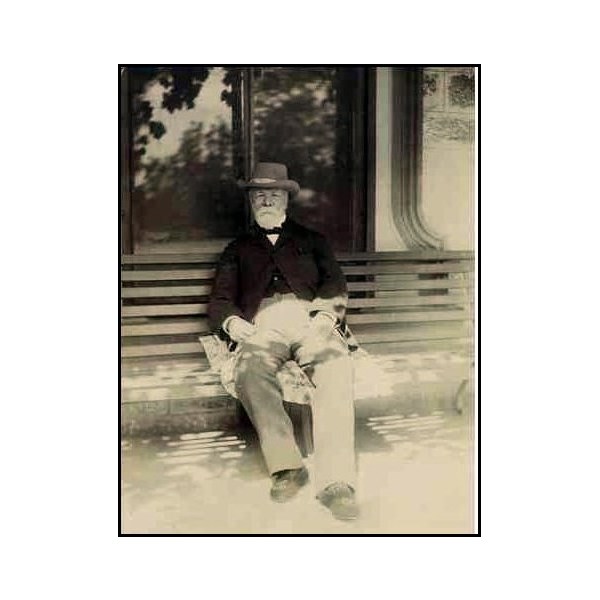
George Woodroffe Goyder 1895
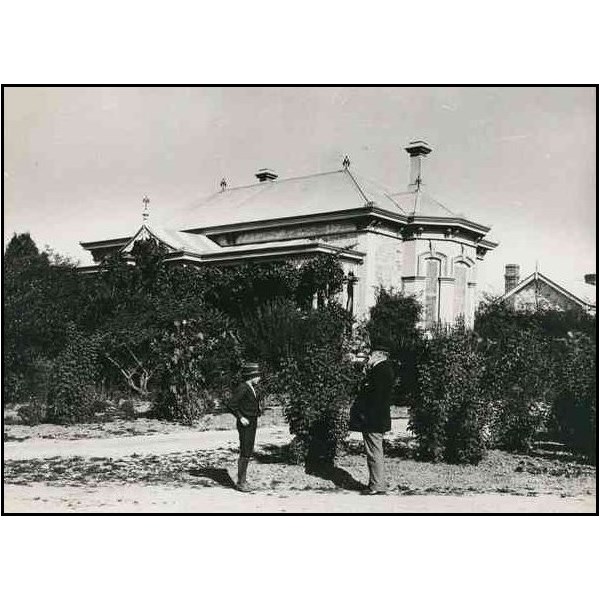
Warrakilla at Mylor, the owner, George Goyder (right) is seen in the garden 1895
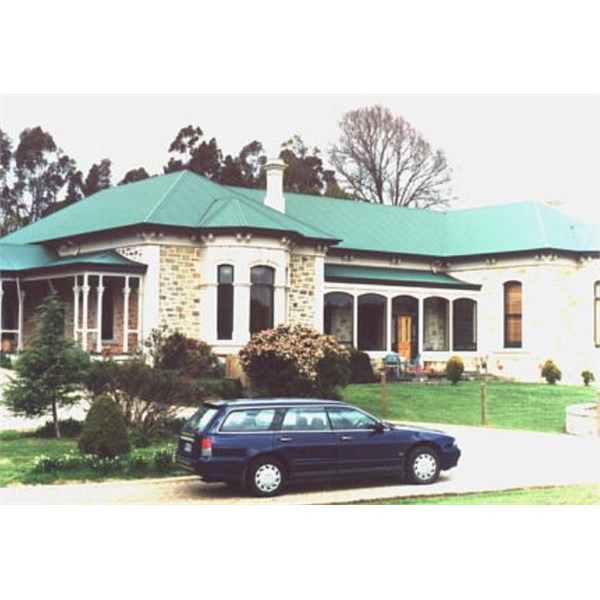
Warrakilla, Goyder's residence. It was restored again after the 1983 Ash Wednesday Bushfires
Goyder consistently overworked himself and his health suffered. For years after 1861 he had scurvy and in 1869 returned from
Darwin with 'nervous and muscular debility' and was ordered complete rest. His wife was then recuperating in England where she died on 8 April 1870 at Bristol from an overdose of sleeping pills. In 1871 Goyder took nine months leave and visited Britain and America leaving his nine children with Ellen Priscilla Smith, his deceased wife's sister. On 20 November he married her: they had one son and twin daughters. Goyder died on 2 November 1898 at his
home Warrakilla, near Aldgate, leaving an estate of £4000. He is buried at the Stirling District
Cemetery.